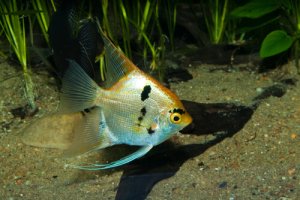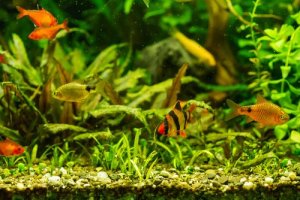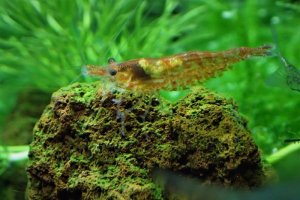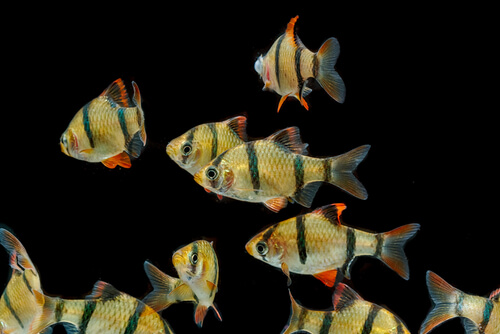
Barbs are a freshwater fish species from the cyprinid family that can be found in natural habitats all the way from Asia through to Africa. Barbs are available in various sizes and color variants, though for the purpose of this article, we will be focusing on the smaller and more colorful barbs for your Community Aquarium.
Species Information
The Barbs are one of many ray-finned fish species that are found in a non-phylogenetic group, and they have quite a few members in the Cyprinid family. Barbs are often kept as pet fish in community tanks and are known to be peaceful schooling fish. They come in many different color variations and sizes, with different color morphs in each species.
So, I do not want to keep you waiting, let’s get started with our list of the 7 best barbs for Your Community Aquarium, and a few details on them.
1. Odessa Barb
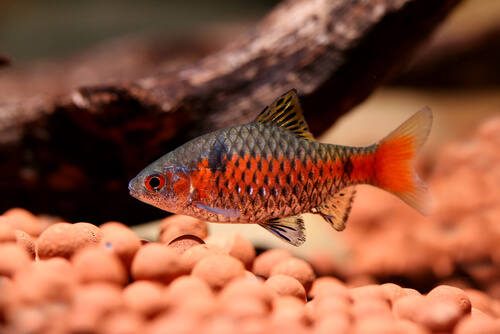
The Odessa Barb (Pethia Padamya) is a spectacular species of smaller barbs originating from Central Myanmar and likewise found in the Chindwin River. They are schooling fish with some striking colors, and a peaceful to semi-aggressive nature depending on how they are kept.
- Colors And Variations – In Odessa Barbs the male will have a beige or lighter brown base color with a bright red stripe across the body, and red eyes with a narrow black streak through them. Males have yellow-green dorsal, anal and pelvic fins with black spots in them. Males become more intense in color when spawning. Female Odessa Barbs has a plainer color with beige bodies and a reflective silver, green sheen. Color variations such as silver, yellow, orange, and black have been noted in Odessa Barbs.
- Water Conditions – Odessa barbs prefer cooler water temperatures of around 64.5 – 71.5° F (14 – 22° C), and a slightly acidic pH of between 6.5 and 8.0. They enjoy water with moderate currents like their natural habitats of streams and rivers.
- Tank Size – Because Odessa Barb needs to be kept in groups of 6 or more fish you will need a larger 75-gallon tank to accommodate the group, and even larger if you plan on adding more tank mates.
- Tank Decorations – Odessa Barb are active and lively, they also make excellent jumpers so a tank with a lid, and plenty of open spaces is ideal. You can use more natural décor such as Rocks and driftwood, with sand or gravel as a substrate. Odessa Barb loves lush plants and may even nibble on them occasionally, so I would advise long-stemmed aquatic plants and floating aquatic plants.
- Fish Size And Lifespan – Generally they do not grow much larger than 4.5cm (1.8 – 2 inches) in size, though there have been instances where they have reached up to 7 cm (2.8 – 3 inches) in size. Odessa span has an overall lifespan of 3 years, but in very good conditions can live up to 5 years.
- Feeding – Odessa Barb are omnivores and likewise very vigorous eaters. They should be fed a variety of meat and plant materials, three times a day, as much as they can eat within five minutes. Good quality flakes, frozen foods such as brine shrimp and bloodworms, and vegetables such as zucchini, pea shells, and spinach that are blanched are just a few main items they enjoy eating.
- Breeding – As with most Barb species they are egg scatterers and will need a separate breeding tank for spawning and to raise the fry. Once the eggs are laid and fertilized, all adult fish need to be removed, as they may eat their eggs. Eggs hatch within 24 hours and the fry will mature within 5-8 months.
- Temperament – Odessa barbs are tremendously fast-moving and need plenty of wide-open spaces for swimming. They are generally peaceful but can become slightly aggressive if not kept in large enough groups.
2. Gold Barb (Chinese Barb)
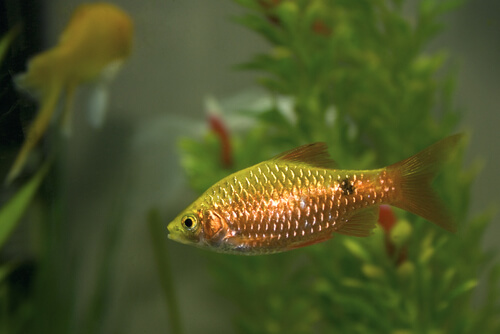
The Golden barb (Barbodes semifasciolatus), similarly known as the Chinese barb is an excellent peaceful to moderately aggressive small communal barb fish species, native to the Red River Basin in Southeast Asia. Golden Barbs are schooling fish that need to be kept in groups of six or more fish, and they do get along well with other smaller peaceful fish species.
- Colors And Variations – An interesting fact is that in its natural environment, the Golden barb has a more greenish color, though in captivity they are a golden yellow color with a slight green tint. The males have a slightly different body shape than the rounder and bulkier females, and much bolder colors than the duller-colored females. The Albino Golden barb comes in a few distinctions such as the more flesh-colored pink, and tri-colored varieties.
- Water Conditions – Water temperatures that are cooler, around 65°F to 78°F (18°C to 26°C), are ideal for Gold Barbs, and they do well with pH ranges between 6.0 and 8.0 which is quite a large spectrum. They are not overly fussy with water conditions but do prefer clean water with a moderate current, so I would suggest a filter that will provide some current.
- Tank Size – A tank of around 20 -30 gallons will be ideal for a group of six or more Gold Barbs, and slightly larger for adding other species of tank mates.
- Tank Decorations – A more natural atmosphere is preferred by Gold Barb including plenty of lush long-stemmed plants and hanging plants, with thick gravel or sand as a substrate. You can use Rocks and driftwood to create hiding spaces. Though, ensure that there is plenty of space for swimming, as they are relatively active simmers.
- Fish Size And Lifespan – Gold Barbs mostly only live for three years, however, if your tank is kept in pristine quality, and they are fed a proper diet they may reach up to five years. Most Adult Gold Barbs are 2.8 inches to 3 inches (7cm-8cm) in size.
- Feeding – Gold Barbs are not fussy eaters though they do like variety in their diet, they are omnivores requiring meat and plant-based foods. Feed them high-quality pellets and flakes, live and frozen foods such as Brine Shrimp, MicroWorms, and Grindal Worms, and vegetables such as zucchini and shelled peas that have been blanched. You can feed them a meal twice a day, and a snack once, feed them enough to finish within three to five minutes, and clean up all wasted food.
- Breeding – Gold Barbs will usually spawn in the early morning and require a separate tank with plenty of plants. You will need equal amounts of males and females, and the adults must be removed after spawning. Eggs will hatch within a day and the fry should be free swimming within another day’s time.
- Temperament – Overall Gold barb are described as peaceful to moderately aggressive, they do nip at fish with long flowing fins and may destroy some of the plants in their tanks.
3. Panda Barb
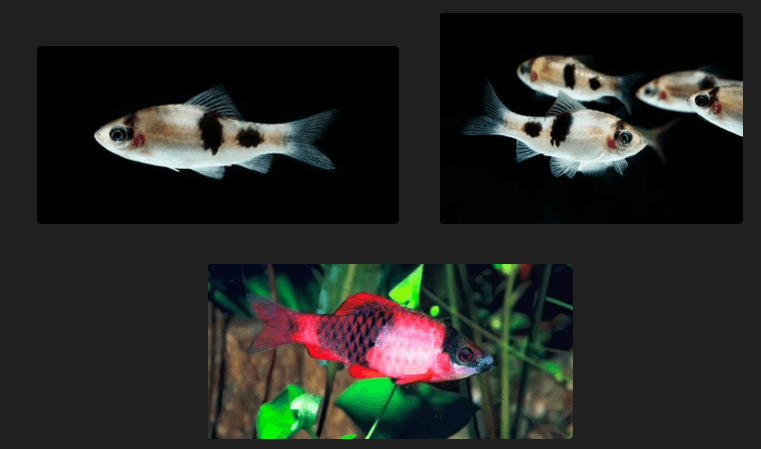
The Panda Barb, or Melon Barbs (Dravidia Pethiyagoda), is quite an interesting barb species that has bold colors and markings and is a smaller peaceful species for your communal tank. It is native to the Western ghats of India, living in tropical water with cooler temperatures.
- Colors And Variations – What I love about the Panda Barb is its striking colors and markings, that is variable, with the 3 or 5 prominent black bars on the sides of their bodies. You do get them in color variants from peach to orange, red, and even the rarer purple color.
- Water Conditions – Panda Barbs enjoy cooler tropical waters with a slightly acidic pH of 6.0 – 7.5, and temperatures of 22–26 °C (72-78°F). You will nevertheless have to compare them with barbs and other species of fish that need more neutral pH levels before adding them to a communal tank.
- Tank Size – A 20-gallon tank is perfect for a group of 6 panda Barbs, as they are schooling fish. If you intend on adding more tank mates I would recommend a larger tank size.
- Fish Size And Lifespan – The Adults are quite small around 6 cm (2.4 in) in size, and they have a lifespan of 3 – 5 years depending on their diet and living conditions.
- Feeding – Panda Barbs are Omnivores and should be fed quality pellets and flakes, alongside fresh or frozen brine Shrimp, and Bloodworms, as well as plant matter including algae and blanched green leafy vegetables. They are moderate eaters and can be fed two to three times a day, only enough for them to finish within a few minutes.
- Breeding – Most Panda Barbs are moderately easy to breed when they are adults at around 5 months. They need a separate breeding tank in which they will spawn and scatter the eggs among thick plants and vegetation. The adults must be removed as they will eat their eggs. The young hatch within a day, and quickly become free swimmers.
- Temperament – Panda Barbs are peaceful schooling fish, but they will nip at fish that have long-flowing fins, attracting their attention.
4. Black Ruby Barb
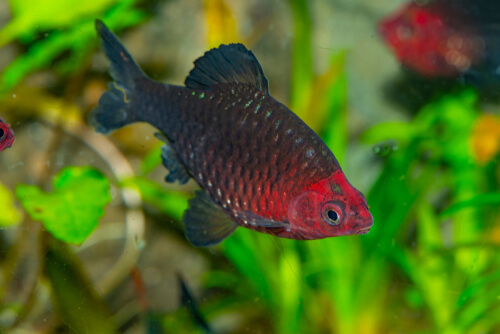
One of my personal favorites is the Black Ruby Barb (Pethia nigrofasciata), which is also known as the purple-headed barb. It is a colorful and friendly schooling fish that has a friendly nature for communal aquariums with other fish species. The Black Ruby Barb originates from Sri Lanka, in natural streams and river basins. They are the most imaginative and vibrant smaller barb species where both the males and females have striking colors.
- Colors And Variations – Young Black Ruby Barbs will appear yellow-gray with prominent black vertical stripes. Eventually, the adult fish become a darker ruby red. Females have basal parts of their fins that are black whereas the whole fin in the males is black. The anal fins are red/black, and the pelvic fins are purple. You may find a few variations in colors and markings in Black Ruby Barbs, however, they will still remain the main colors and markings.
- Water Conditions – These barbs enjoy tropical climates and quiet flowing streams with fresh water, in shaded areas. A more acidic pH of 6.0 to 6.5 is ideal and water temperatures of 72–79 °F (22–26 °C).
- Tank Size – Black Ruby Barbs are schooling fish kept in groups of six or more fish, and need at least a 20 to the 30-gallon sized tank.
- Tank Decorations – The tank decoration and set-up are slightly more tricky as they need half-light and half-shade, which you can achieve with floating plants. You can use sand and gravel substrate with a layer of humus on top and plenty of long-stem live plants on the edges of the tank. They need space in the center for swimming. Driftwood and larger pebbles and rocks can be used for additional natural décor.
- Fish Size And Lifespan – Black Rosy Barb fish are quite small, rarely reaching more than 2 inches 95cm) in size, and they have a relatively short lifespan of around three or more years.
- Feeding – The Omnivorous Black Ruby Barb enjoys a diet of Detritus which consist of dead organic materials, and dead organisms, as well as algae. You can likewise feed them specialized quality pellets and flakes. Feed them two to three times a day, enough to finish within 2 to 5 minutes at most.
- Breeding – They are egg-scattering fish, requiring a separate breeding tank with shallow water and plenty of plants. Eggs hatch within 24 hours, and the fry is free swimming the next day. The parent will likewise need to be separated after spawning.
- Temperament – Black Ruby Barbs have a temperament much like Panda Barbs, they are quite peaceful and active swimmers but will nip at fish with long flowing fins that might seem interesting to them.
5. Cherry Barb
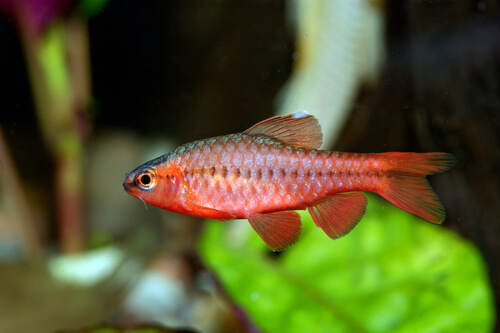
The Cherry barb has a delightful red-to-orange color that will surely brighten up your community Aquarium. It is a peaceful schooling fish that is small and very easy to care for. The Cherry Barb (Puntius Titteya), is a tropical fish that is native to Sri Lanka. Though one issue that I need to address is the fact that they are quite sensitive fish, prone to disease, thus the utmost care should be taken with their tank conditions.
- Colors And Variations – Most Cherry Barbs will be a primary color of red or tan, and they will have flecks of red or orange, and there will be a darker line of scales along the midline of the body. The female has a white belly and a more greenish body color with a lighter midline. There are on the other hand quite a few other color morphs in Cherry barbs, still the red, orange, and yellow morphs are the most found.
- Water Conditions – Cherry barbs are found in heavily shaded water that is shallow, and calm, in their natural habitat. They prefer cooler water with a pH of between 6.0 and 8.0, and temperatures if between 73 °F to 81 °F (23 °C to 27 °C).[2]
- Tank Size – As a group of six or more Cherry barbs require a community tank of 20 to 30 gallons at least, with additional space should there be other species. Cherry Barbs need to be kept in a ratio of two females per male to prevent aggressive behavior.
- Tank Decorations – Your Cherry barbs are active and will enjoy some swimming space, though they love the cover of floating plants and plenty of planted plants, rocks, and driftwood that resembles their natural habitat. The best substrate to use will be thicker soils and gravel to easily plant live plants.
- Fish Size And Lifespan – Cherry Barbs surprisingly are one of the longest living smaller barbs that we have listed so far, with a lifespan of between 4 and 7 years. They can reach a size of around 5 cm (2inches), therefore they are also quite small.
- Feeding – As with most barb species Cherry Barbs are Omnivores and enjoy a diet of flakes, pellets, algae, as well as, live and frozen foods, and green leafy vegetables. Live foods such as Brine Shrimp and bloodworms are the most popular. While vegetables including zucchini and shelled peas are usually favored.
- Breeding – Spawning takes place in separate tanks where the male will chase other males away from a female. She lays between 200 and 300 eggs, after which all adult fish are removed from the breeding tank. The eggs hatch in two days and the fry takes another two days before they become free swimming.
- Temperament – Cherry barbs are known to be the most peaceful of barb species if kept in groups of 6 or more. They are schooling fish that are quite likely to form a hierarchy. Males love to chase the females around relentlessly, therefore, it’s best to have more females than males.
6. Checker Barb
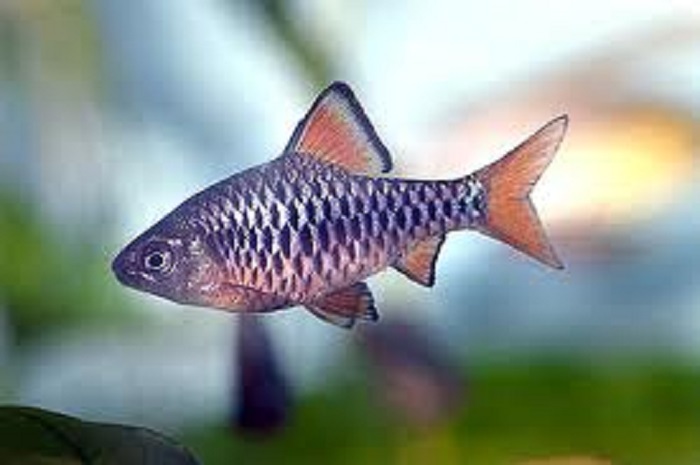
The Checker, or Checkered Barb (Oliotius oligolepis) is a peaceful schooling fish that needs to be kept in groups of 6 or more, with most females, as males may occasionally brawl among each other. It is native to Sumatra, Indonesia, and Colombia, and is a Tropical fish found in lakes, rivers, and creeks.
- Colors And Variations – Adult males will have red fins with black tips, and shiny silver scales with black scaling mimicking a checkerboard. There are two varieties of Checker Barbs, the one with greenish fins and the one with red fins. The females are similar in color, but much larger and bulkier than the males.
- Water Conditions – Checker Barbs enjoy cooler water temperatures of around 68–75 °F (20–24 °C) and pH levels of between 6.0 and 6.5.
- Tank Size – Checker barbs are kept in groups of at least 6, thus needing a tank of between 20 and 30 gallons per group, and larger if you are keeping more species of fish. I would similarly suggest keeping more females than males, as males tend to spar with each other.
- Tank Decorations – Checker Barbs enjoy a well-planted and more natural tank, with sandy or gravel substrate and floating, or planted aquatic plants that they can hide under, and occasionally nibble on.
- Fish Size And Lifespan – The Checker Barb takes our top spot for one of the smaller barbs having the longest lifespan of 8 years in captivity. They are small 5 cm (2.0 in) and will do well with similar sized tank mates.
- Feeding – The Checker barb is an omnivore that will feast on a variety of small worms, crustaceans, and insects, as well as blanched leafy greens, and good-quality flakes and pellets. They will eat with eagerness and can be fed small amounts three times a day.
- Breeding – Checker Barbs are egg scatterers that spawn in the early mornings on plants in the female’s territory. Therefore, females are introduced into the breeding tank first. Both are removed after spawning. The eggs will hatch within a few days if water temperatures are kept slightly higher. The young fry will take a few days before they swim freely.
- Temperament – Generally the Checker Barb is known to be peaceful and gets along well with other species tank mates. They are schooling fish that must be kept in groups with more females than males.
7. Ticto Barb
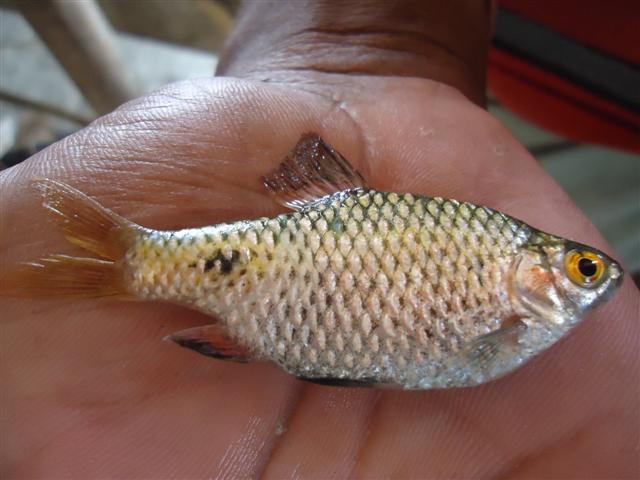
The Ticto Barb, also known as the Stolickae’s or Pethia Stoliczkana, is a small sized active, schooling fish that is an excellent addition to your community tank. It is native to Nepal, India, Pakistan, Bangladesh, Thailand, and Sri Lanka. The Ticto barb thrives in a well planted environment like the still shallow water of their natural environment.
- Colors And Variations – Many times the Ticto Barb is confused with the much similar Odessa Barb. Though, the Odessa barb has more of an orange color, whereas the Ticto Barb is silver or gold, with black spots near the tail and pectoral fins on their body.
- Water Conditions – Water temperatures of 14–22 °C (57–72 °F), are ideal with silty and still water that has a pH of between 6.0 and 7.0, and water hardness of around 10dGH.
- Tank Size – A 20 Gallon tank is needed, as the Ticto Barbs need to be kept in groups of 5 or more fish.
- Tank Decorations – Ticto Barb enjoys a tank with lush plants and sand or gravel substrates. They will likewise need ample space for swimming.
- Fish Size And Lifespan – Ticto Barb grow up to 10 cm (4 inches),
- Feeding – They are omnivores and will feed on small crustaceans, insects, and plant matter. Quality fish flakes or small pellets are ideal, and a diet of brine shrimp, daphnia, blood worms, and plants including lettuce, spinach, and zucchini has been blanched.
- Breeding – Ticto Barbs are egg layers and enjoy spawning on coarse gravel layers. They need to be removed as they will eat the eggs and young. The eggs hatch within a day, and the fry will be free swimming the next day.
- Temperament – The Ticto Barb is peaceful and an active swimmer that will not bother other fish. They need to be kept in groups to prevent them from becoming aggressive.
How We Chose The Community Aquarium Barbs
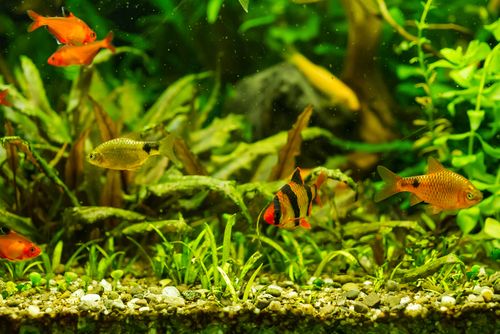
As you may have noticed most barb fish species come in varied sizes from very small sized fish such as the Black Ruby Barbs, and the very large Tinfoil barb species, so we have concentrated mainly on the smaller-sized barb species. I have added basic information on every species, yet, you will need to refer to the specific Care Guides on our site, for each species, for more in-depth information.
I chose the Barb fish species for communal aquariums according to the following criteria;
- Size And Lifespan– We have tried to stick to smaller barbs that are between 4.5cm (1.8 – 2 inches) in size, 7 cm (2.8 – 3 inches) in size at the largest. They mostly have a lifespan between 3-5 years.
- Water Condition Compatibility – As you will see some of the barbs prefer slightly more acidic water conditions, though most barb species are quite forgiving in this aspect. They mostly enjoy cooler temperatures and can easily adapt to temperatures as tropical fish; we have tried to stick to similar temperature requirements.
- Temperament – The smaller barbs are usually between peaceful and some are moderately aggressive, though nothing to worry about. If you keep them in groups of six or more fish, they will be relatively calm and peaceful as they are all schooling species. Keep in mind most barbs are active and tend to jump, so invest in a tank with a lid.
- Compatibility with Other Species – Most barb species will get along with small peaceful fish species, just try to avoid species that have long flowing tails, and that can be aggressive. I found that the best tank mates for most smaller barbs are Tetras, Danios, Plecos, Rasboras, Platys, Dwarf Gouramis, and Loaches.
- Diet – All of the smaller barbs that we have chosen are omnivores, and enjoy a varied diet, with three meals a day, one being a snack. They will eat fresh and frozen meat-based foods, green leafy vegetables, algae, as well as quality pellets and fish flakes meant for their species.
- Tank Requirements – You may notice that most of the barbs we have chosen come from natural streams, springs, and river basins. Thus, they enjoy a moderate current from their filtration system. They are active swimmers that enjoy space to swim, as well as plenty of plants on the edges of their tank. The average tank size for a group of 6 of the smaller barbs is around 20 to 30 gallons.
In Conclusion
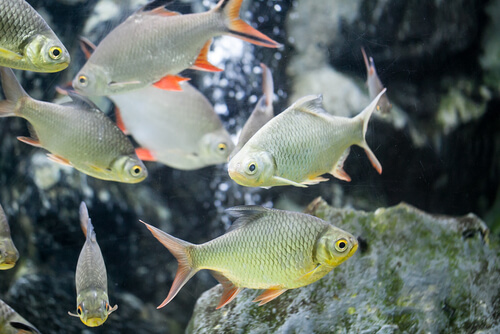
Hopefully, our list has narrowed it down for you to find the perfect Barb species for your communal tank. They are all schooling fish that need to be kept in groups of at least 6, and they are small fish that get along well with other species’ tank mates. They are active and lively fish that are fun to watch with some funny antics. If kept in the right tank conditions, they are hardy and you should have very little issues with them as a pet.
Just remember most of them enjoy jumping, so keep a lid on your tank!


